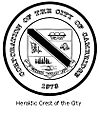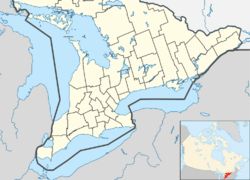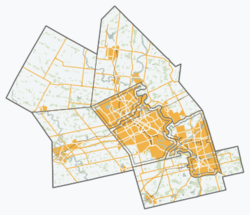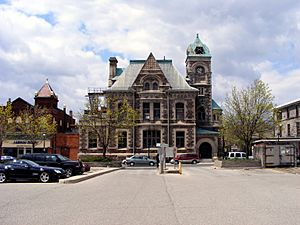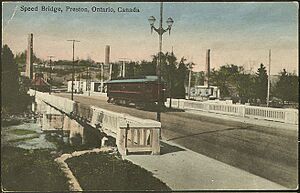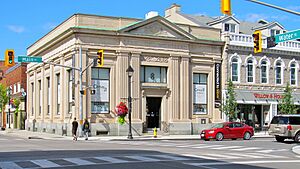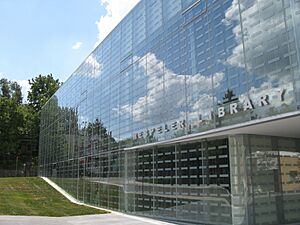Cambridge, Ontario facts for kids
Quick facts for kids
Cambridge
|
|||||
|---|---|---|---|---|---|
| City of Cambridge | |||||

Grand River scene facing downtown Cambridge (Galt)
|
|||||
|
|||||
| Nicknames:
The Bridge, the Tri-City
|
|||||
| Motto(s):
"A fine place for business, a great place to call home."
|
|||||
| Country | Canada | ||||
| Province | Ontario | ||||
| Region | Waterloo | ||||
| Established | January 1973 | ||||
| Area | |||||
| • Land | 112.99 km2 (43.63 sq mi) | ||||
| Elevation | 329 m (1,079 ft) | ||||
| Population
(2021)
|
|||||
| • City (lower-tier) | 138,479 (41st) | ||||
| • Density | 1,225.5/km2 (3,174/sq mi) | ||||
| • Metro | 575,847 (10th) | ||||
| Time zone | UTC−5 (Eastern (EST)) | ||||
| Forward sortation area |
N1P to N1T, N3C to N3E, N3H
|
||||
| Area code(s) | 519, 226, and 548 | ||||
| Highways | |||||
| GNBC Code | FANXK | ||||
Cambridge is a city in Ontario, Canada. It is located where the Grand River and Speed River meet. In 2021, about 138,479 people lived here. Cambridge is one of the three main cities in a large area, along with Kitchener and Waterloo.
Cambridge was created in 1973. It was formed by joining several smaller communities. These included Galt, Preston, Hespeler, and the village of Blair. Galt makes up the largest part of the city, covering the southern half. Preston and Blair are on the western side, and Hespeler is in the northeast.
Contents
History of Cambridge
The land where Cambridge is today has been home to Indigenous peoples for a very long time. Archaeologists found an old village site from about 1280 to 1360 CE. These people might have been the Chonnonton Peoples, who spoke the Iroquoian language. They grew crops like corn, beans, and squash. Later, in the late 1600s, the Mississauga people, who spoke Algonkian, moved into this area.
How Galt Started
Galt is on land that was given to the Iroquois people by the British after the American Revolutionary War. In the late 1700s, people started buying land from the Six Nations. In 1816, a rich Scottish immigrant named William Dickson bought a huge amount of land along the Grand River. This land later became Galt and the Dumfries Townships. Dickson sold smaller pieces of land, especially to Scottish settlers. The main part of the new community was built where Mill Creek and the Grand River met. It was first called Shade's Mills.
Dickson decided to name the Post Office Galt. This was to honor John Galt from the Canada Company. Galt was mostly farms at first. But by 1840, it had many factories and became the biggest town in the Grand River area. It was even called "Manchester of Canada" because of all its industries. These factories used the power of the Grand River. Some important businesses around 1870 included mills, axe factories, furniture factories, and wool factories.
In 1846, Galt had good water power for mills. The downtown area had stone buildings. About 1,000 people lived there, mostly from Scotland. There was a curling club, a library, a newspaper, a school, and a bank. Industries included grist mills, saw mills, foundries, and breweries.
The Galt Grammar School opened in 1852. It became very famous and attracted students from all over North America. Galt became a town on January 1, 1857. Morris C. Lutz was its first mayor. A "Town Hall and Market House" was built in 1858.
The railway came to Galt in 1879. This made it easier to send goods out and bring things in. The Credit Valley Railway built freight and passenger buildings in Galt in 1873. By 1879, they had a bridge over the river. The Canadian Pacific Railway took over the line in 1883.
The first hospital in Waterloo County opened in Galt in 1890. It was called Galt General Hospital. More buildings were added later. By 1918, it had an X-ray room and a nursing school.
An electric streetcar system started in 1894. It connected Preston and Galt. By 1911, it reached Hespeler, Kitchener, and Waterloo. This system stopped running in 1955. Galt became a city in 1915 and kept growing.
In May 1974, after Galt became part of Cambridge, the Grand River flooded. Water was up to 4 feet deep in the streets. Some downtown areas had water 17 feet deep. This caused about $5 million in damage to businesses.
How Preston Started
Preston was built on land bought from the Six Nations Indians. The name Preston comes from William Scollick's hometown in England. He was a surveyor.
In the 1800s, German-speaking Mennonites from Pennsylvania came to the area. John Erb, a Mennonite, arrived in 1805. He bought a lot of land, including where the Grand and Speed Rivers meet. He built a sawmill in 1806 and a gristmill in 1807. This settlement was first called Cambridge Mills.
The area had homes, a store, and small shops. Most early settlers were from Germany. William Scollick surveyed the area in 1834. He convinced the Erbs to rename Cambridge Mills to Preston.
In 1836, only 250 people lived in Preston. By 1855, there were about 1600 people, with 70% from Germany. The town had eight hotels and taverns. The Preston post office opened in 1837. Preston became a village in 1853.
The population grew again around 1900 because of new electric railways. By 1911, the electric line reached Hespeler, Kitchener, and Waterloo. This made travel and trade much easier.
By 1879, Preston had many factories. These included a foundry, carriage makers, and furniture companies. The Cherry Flour Mills started in this year. It is now Dover Flour Mills, which still operates today.
The Preston Springs Hotel opened in 1888. It was torn down in 2020 for safety reasons. Preston became a town on September 30, 1899. It had almost 11,000 people. Roads and railways helped it become an important industrial center.
How Hespeler Started
The area that became Hespeler was also bought from the Six Nations Indians. Abraham Clemens was the first settler in 1809. He bought land on the Speed River. In 1810, Cornelius Pannabecker set up a blacksmith shop. Twenty years later, Joseph Oberholtzer bought a larger area. It was first called Bergeytown, then New Hope around 1835.
Jacob Hespeler arrived in 1845. He bought land on the Speed River and built factories. This started Hespeler's industrial growth, mainly with wool and textile mills. In 1846, Hespeler had about 100 people. It had a grist mill, saw mill, tannery, and other small businesses.
In 1858, Jacob Hespeler opened the Post Office. The settlement, New Hope, was renamed Hespeler and became a village. The railway arrived in 1859, helping businesses grow. By 1864, there was a large flour mill, wool factories, and a distillery.
Hespeler became a town in January 1901. The electric railway system reached Hespeler by 1911. Textile mills were the main industry until the late 1940s. By 1969, Hespeler had 6,000 people.
How Blair Started
The land for Blair was bought from the Six Nations by Richard Beasley. Samuel D. Betzner, a Mennonite from Pennsylvania, settled there in 1800. The first school in Waterloo County opened near Blair in 1802. It was then called Shinglebridge.
The first cemetery in Waterloo County was founded in Blair in 1804. Joseph Bowman and others helped develop the community. They built a dam, a sawmill, and a grist mill. In 1846, a large flour mill opened.
In 1858, the first post office in the area was named Blair. This was to honor Adam Johnston Fergusson Blair, a local judge. Earlier names for the village included Shinglebridge and Durham.
By 1864, Blair had a school, a Mennonite meeting house, and a population of 200. Railway service came to Blair in 1873. Blair became part of Preston in 1969. Many old buildings still stand in the village, some from the early 1820s.
City Services
The City of Cambridge provides many services. These include community services, economic development, and public works. They also manage the Fire Department and planning.
Many services are also provided by the Regional Municipality of Waterloo. This region includes Cambridge, Kitchener, Waterloo, and four townships. The region handles social services, health services, public transit, and policing.
Hospital
Hospital services are provided by Cambridge Memorial Hospital. A small hospital opened in Galt in 1890. The current hospital was finished in 1953. It has been expanded over the years. A big expansion project started in 2014. It will add more beds and improve many programs.
The expansion faced some delays. But a new patient care wing was completed in late 2019. It was planned to open in January 2020.
Weather in Cambridge
Cambridge has a typical climate for southwestern Ontario. It has warm summers and cold winters. Summer temperatures are usually in the high twenties Celsius. Sometimes, it can feel very humid. Cambridge is often a little warmer than Kitchener and Guelph.
The last frost of spring usually happens around May 11. Most gardeners wait until the May 24 long weekend to plant.
| Climate data for Cambridge, Ontario (1981−2010) | |||||||||||||
|---|---|---|---|---|---|---|---|---|---|---|---|---|---|
| Month | Jan | Feb | Mar | Apr | May | Jun | Jul | Aug | Sep | Oct | Nov | Dec | Year |
| Record high °C (°F) | 17.8 (64.0) |
14.4 (57.9) |
24.0 (75.2) |
30.0 (86.0) |
35.0 (95.0) |
36.0 (96.8) |
37.8 (100.0) |
37.8 (100.0) |
37.2 (99.0) |
32.2 (90.0) |
25.0 (77.0) |
19.5 (67.1) |
37.8 (100.0) |
| Mean daily maximum °C (°F) | −1.7 (28.9) |
−0.8 (30.6) |
4.2 (39.6) |
12.3 (54.1) |
19.0 (66.2) |
23.9 (75.0) |
26.7 (80.1) |
25.1 (77.2) |
20.3 (68.5) |
13.7 (56.7) |
6.8 (44.2) |
0.6 (33.1) |
12.5 (54.5) |
| Daily mean °C (°F) | −6 (21) |
−5.5 (22.1) |
−0.9 (30.4) |
6.8 (44.2) |
12.8 (55.0) |
17.6 (63.7) |
20.6 (69.1) |
19.4 (66.9) |
14.6 (58.3) |
8.4 (47.1) |
2.8 (37.0) |
−3.2 (26.2) |
7.3 (45.1) |
| Mean daily minimum °C (°F) | −10.2 (13.6) |
−10.1 (13.8) |
−6.0 (21.2) |
1.2 (34.2) |
6.6 (43.9) |
11.3 (52.3) |
14.4 (57.9) |
13.5 (56.3) |
8.9 (48.0) |
3.0 (37.4) |
−1.1 (30.0) |
−7.1 (19.2) |
2.1 (35.8) |
| Record low °C (°F) | −35.6 (−32.1) |
−31.7 (−25.1) |
−30.0 (−22.0) |
−15.6 (3.9) |
−5.0 (23.0) |
−0.6 (30.9) |
4.4 (39.9) |
1.0 (33.8) |
−3.9 (25.0) |
−10.0 (14.0) |
−20.0 (−4.0) |
−28.5 (−19.3) |
−35.6 (−32.1) |
| Average precipitation mm (inches) | 55.4 (2.18) |
47.4 (1.87) |
50.2 (1.98) |
71.3 (2.81) |
84.2 (3.31) |
74.1 (2.92) |
111.6 (4.39) |
91.5 (3.60) |
86.9 (3.42) |
71.9 (2.83) |
86.8 (3.42) |
74.0 (2.91) |
905.2 (35.64) |
| Average rainfall mm (inches) | 18.1 (0.71) |
18.1 (0.71) |
35.4 (1.39) |
68.9 (2.71) |
84.2 (3.31) |
74.1 (2.92) |
111.6 (4.39) |
91.5 (3.60) |
86.9 (3.42) |
71.0 (2.80) |
81.3 (3.20) |
44.3 (1.74) |
785.4 (30.92) |
| Average snowfall cm (inches) | 37.8 (14.9) |
29.3 (11.5) |
14.8 (5.8) |
2.4 (0.9) |
0.0 (0.0) |
0.0 (0.0) |
0.0 (0.0) |
0.0 (0.0) |
0.0 (0.0) |
0.91 (0.36) |
7.3 (2.9) |
29.7 (11.7) |
122.2 (48.1) |
| Average precipitation days (≥ 0.2 mm) | 11.7 | 8.9 | 9.6 | 12.9 | 12.0 | 9.2 | 10.1 | 10.2 | 11.9 | 12.7 | 12.7 | 12.2 | 133.8 |
| Average rainy days (≥ 0.2 mm) | 3.2 | 2.3 | 5.9 | 12.0 | 12.0 | 9.2 | 10.1 | 10.2 | 11.9 | 12.6 | 11.5 | 6.2 | 106.8 |
| Average snowy days (≥ 0.2 cm) | 9.2 | 7.0 | 3.8 | 1.1 | 0.0 | 0.0 | 0.0 | 0.0 | 0.0 | 0.23 | 1.9 | 6.2 | 29.3 |
| Source: Environment Canada | |||||||||||||
Economy and Film Industry
Toyota Motor Manufacturing Canada opened a large car plant in Cambridge in 1988. It employs about 4,500 people and is the city's biggest employer. Many other companies also have factories or offices here. These include Rimowa, Gerdau, ATS Automation Tooling Systems, and Dare Foods.
Cambridge is also a popular place for filming movies and TV shows. Filmmakers like the city's European-style buildings and its closeness to Toronto. In 2016, 15 projects were filmed in Cambridge in just 21 days. Filming in Cambridge brought $1.2 million to the local economy in 2016. Seeing Cambridge on screen makes the community proud.
Some famous films shot in Cambridge include John Q (2002) and Red (2010). TV series like Murdoch Mysteries (2008–) and The Handmaid's Tale (2017–) have also filmed here. In 2019, Cambridge was nominated for an award for its work on The Handmaid's Tale.
Education in Cambridge
Cambridge has many schools for students. Public English schools are run by the Waterloo Region District School Board. There are 26 elementary schools and five high schools.
High schools include the very old Galt Collegiate Institute and Vocational School, Preston High School, and Jacob Hespeler Secondary School.
Catholic schools are run by the Waterloo Catholic District School Board. They have 15 elementary schools and two high schools: St. Benedict Catholic Secondary School and Monsignor Doyle Catholic Secondary School. Cambridge also has École secondaire Père-René-de-Galinée, which is the only French-language Catholic high school in the region.
For higher education, the University of Waterloo School of Architecture has a campus in Cambridge. It is located in a historic building called the Riverside Silk Mill. About 380 students study architecture here.
Conestoga College also has a campus in Cambridge. In 2009, they opened a new School of Engineering Technology. It focuses on robotics, automation, and electronics. In 2019, Conestoga College bought more land in Cambridge. They plan to move all their trades and apprenticeship programs here in the future.
Fun Things to Do in Cambridge
Cambridge has many fun events and activities. These include the Mill Race Festival and Rock the Mill music festivals in downtown Galt. The Cambridge Highland Games are held in Churchill Park in July.
You can also visit the Cambridge Butterfly Conservatory. There's an annual dragon boat festival, the Cambridge fall fair, and a Santa Claus Parade.
During Christmas, there's a "Christmas in Cambridge" festival. It features events like Unsilent Night, which uses cool digital projections. Students from the University of Waterloo School of Architecture help design the light displays.
The Cambridge Farmers' Market has been open since about 1830. This makes it one of the oldest markets in Canada. It's even ranked as one of the top 10 markets in the country. All the sellers come from within 100 km to sell fresh fruits, cheese, vegetables, and baked goods.
The Cambridge Centre of the Arts is a community arts center. It's open to local artists and residents. Cambridge Galleries are part of the Cambridge Public Library system. They have art shows at different locations. The Cambridge Libraries are also restoring an old post office into a digital library. It will have 3D printers, maker labs, and a large children's area.
The Dunfield Theatre opened in 2013. It was built to support Canadian talent and performing arts. This theater has 500 seats. In 2018, its name was changed to the Hamilton Family Theatre.
Cambridge City Hall opened in 2008. It was the first city hall in Canada to get a gold rating for being environmentally friendly. The building saves a lot of energy each year. It has an open design for better airflow and natural light. There's also a "living wall" of plants that cleans the air.
The historic city hall in Cambridge was built in 1858. It was made of granite and limestone. It used to be the town hall and marketplace. Today, the old and new city halls are connected by a hallway.
Cambridge has over 365 hectares of parkland, with more than 80 parks. It also has over 140 km of cycling lanes and trails. Many trails run along the Grand and Speed Rivers.
Population and People
In 2021, Cambridge had a population of about 138,479 people. The average age was 39.2 years. About 17.7% of the people were under 15 years old, and 16% were 65 or older.
Most people in Cambridge are of European background. The largest groups are English, Irish, Scottish, and German. There are also many people from Portugal, India, and other parts of the world. In 2021, about 74.3% of the population was White. About 23.9% were visible minorities, and 1.9% were Indigenous. The largest visible minority group was South Asian.
Most people in Cambridge identify as Christian. Other religions include Muslim, Sikh, and Hindu. About 31.4% of the population reported having no religious affiliation.
Getting Around Cambridge
Roads
Cambridge has two main roads that cross each other, forming an 'X'. This intersection is called the Delta. It used to get very busy because of trains. A bridge was built over Hespeler Road in 2012 to help with traffic.
Highway 8 (Ontario) goes through Cambridge. It connects the city to Kitchener and Waterloo in the west, and Hamilton in the east. Highway 24 also runs through Cambridge. It connects to Guelph in the northeast and Brantford in the south.
Bridges
Cambridge has some very old and important bridges. The Black Bridge Road Bridge (1916) is the only truss bridge in Cambridge. It's a heritage site. The Main Street Bridge (1931) is a concrete arch bridge over the Grand River. The Mill Creek Bridge (1837) is the oldest bridge structure in the region.
In 2007, a pedestrian and cycling bridge was built over Highway 401. It connects Cambridge and Kitchener and is part of the Grand River trails.
Public Transportation
Since 2000, public transport in the Region of Waterloo has been provided by Grand River Transit (GRT). GRT runs many bus routes in Cambridge. Some routes go within Cambridge, and others connect to Kitchener and Waterloo.
The Ainslie Street Terminal is the main bus station in Cambridge. Sportsworld GO is the main hub for GO Transit buses. Coach Canada also runs buses between Hamilton, Kitchener, and Niagara Falls.
Railways
The Canadian Pacific Railway's Galt Subdivision is the main railway line in Cambridge. It passes through Galt. This line connects Toronto with cities to the southwest.
Cambridge does not currently have passenger train service. The closest train stations are in Kitchener, Guelph, and Brantford. There are proposals to bring GO train service to Cambridge in the future.
Light Rail
Cambridge used to have an electric street railway system. It connected Galt, Preston, and Hespeler. This system stopped running in 1955.
Today, the Waterloo region has a plan for a new light rail transit (LRT) service. The first part of the Ion LRT started in 2019. It runs between Waterloo and Kitchener. The second part of the plan is to extend the LRT to Cambridge. Until then, special Ion buses connect Cambridge to the LRT in Kitchener-Waterloo.
Sports and Fun
Cambridge has over 365 hectares of parkland and 99 parks. It also has over 140 sports fields and many golf courses. There are more than 70 km of trails for walking and cycling.
Sports Teams
The Cambridge Turbos are a very successful National Ringette League team. They have won six national titles. Cambridge is also home to the Greater Ontario Junior Hockey League's Cambridge Redhawks. They won the Sutherland Cup in 2006 and 2007.
The Scorpions Youth Volleyball Club started in 2009. It has over 400 young people in its programs. The Cambridge Aquajets are a competitive swim team that started in the 1950s.
The Galt Red Wings were a junior ice hockey team in Galt from 1944 to 1947. Gordie Howe, a famous hockey player, played for them in 1944–45.
Recreational Buildings
Cambridge has 6 public ice skating arenas. These include Dickson Centre and Galt Arena Gardens, which is the oldest operating arena in Ontario. There are also 2 public indoor pools and 3 public outdoor pools.
The Preston Lawn Bowling Club is in the Preston area of the city. In 2008, the COM DEV Indoor Soccer Park was completed. This large facility helps many kids play soccer in the area.
Famous People from Cambridge
Many talented people have come from Cambridge, including:
- Tim Brent, hockey player
- Nathan Brannen, Olympic runner
- Jessica Camara, boxer
- Adam Butcher, actor
- Derrick Campbell, Olympic speedskater
- Alexandra Chaves, dancer and actress
- Louie DeBrusk, hockey player and announcer
- Jake Dotchin, hockey player
- Rob Ducey, baseball player
- Hayley Elsaesser, fashion designer
- J. R. Fitzpatrick, NASCAR racer
- Madeline Gardiner, Canadian Olympic gymnast
- Peter Gzowski, writer and CBC Radio host
- Kirk Maltby, hockey player
- Victoria Moors, Canadian Olympic gymnast
- Hilda Ranscombe, captain of the Preston Rivulettes
- Jim Schoenfeld, hockey player
- Ron Shaver, figure skater
- Scott Thorman, baseball player
- Yvonne Tousek, Canadian Olympic gymnast
Images for kids



